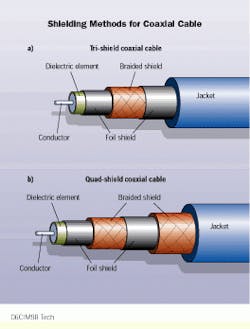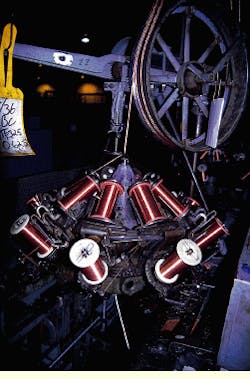Coaxial cable finds niches outside campus networks
The medium has proved that tales of its death are greatly exaggerated.
Patrick McLaughlin
"Each of the past several years has been predicted by some to be the year of coaxial cable`s death," says Fred Galle, marketing manager with cable manufacturer CommScope (Claremont, NC). "But sales of our coaxial cable keep increasing every year. And as more high-bandwidth applications are widely implemented, the communications industry keeps coming back to coaxial cable."
That remark may sound off base to someone who focuses solely on corporate local area networks (lans) because in the corporate lan, unshielded twisted-pair (utp) cable has been the dominant infrastructure medium for several years. How-ever, a broader view, encompassing wide area communications networks and even residential voice, data, and video networks, reveals significant need for the capabilities that coaxial cable provides.
Scarce lan deployment
Cable manufacturers and installers agree that coaxial cabling sees little action in the corporate lan. "In the early and mid-1980s, when nearly every network had a Token Ring configuration, coaxial cable was widely used," says Delton Smith, an engineering specialist with CommScope. "But compared to twisted-pair, coaxial cables get quite bulky in a wiring closet." This large footprint was one of several factors leading to utp`s emergence and coaxial cable`s downfall in premises networks, Smith says.
"When the original lans were put together, utp cable was not available," adds Bob Marretta, an engineer with Coleman/ cci (Sanford, NC), a cable manufacturer. "But over the last 10 years, utp cables have been developed with the characteristics necessary to handle network traffic." He adds that both ease of use and a bit of marketing also helped utp`s cause. "In some ways, utp cabling was marketed better than coaxial cable, so that generated industry interest. Coaxial cable is also more difficult to terminate than utp. Many installers pull and terminate 25,000 feet of utp cable a day; you couldn`t pull and terminate that much coaxial cable every day."
Michael Lagana, registered communications distribution designer (rcdd) and project supervisor with the network design and installation firm U.S. Information Systems (Nyack, NY), says that ease-of-use issues that surround coaxial cable do not end once the installation is completed. "If you use coaxial cable in a ring or bus topology, then moves, adds, and changes are more difficult to accomplish and to document than they would be if you used utp cable. Changes in a coaxial-cable-based network can disrupt a lot of users. On the whole, coaxial cable is not as accommodating as twisted-pair cable."
Anatomy of a cable
With a quick look, you can easily distinguish coaxial cable from utp, shielded twisted-pair (stp), or fiber-optic cable. But it takes more than a simple glance to tell one type of coaxial cable from another. Each type has some of the same basic components, but coaxial cables differ in several ways, including the manner in which they are shielded, the makeup of the dielectric material, and even the composition of the conductor.
Starting from the center and working outward, a coaxial cable consists of a conductor, dielectric material, shielding components, and an outer jacket. The conductor can comprise solid or stranded material, which can be copper or a mixture of copper and another component, such as aluminum, steel, or tin. Solid conductors provide the best performance in terms of distortion and signal loss, but can sometimes break if they are flexed repeatedly. Stranded conductors are better than solid ones at accommodating frequent flexing. Conductors that include copper and another material typically are stronger than all-copper ones.
The dielectric material, which acts as a buffer between the conductor and shielding components, allows the cable to maintain consistent electrical properties and minimize signal loss. The material can be either solid or foamed; foamed materials provide lightweight composition and contribute to increased clarity in high-speed transmission.
The widest variance among coaxial-cable constructions lies in the shielding materials, which protect against signal loss and help prevent electromagnetic interference and radio-frequency interference in the circuit. Several combinations of foils and braids are used to achieve various levels of shielding performance. Coaxial cable commonly referred to as "tri-shield" cable has three layers of shielding; "quad-shield" coaxial cable includes four shielding layers.
A coaxial cable`s jacket is an additional form of insulation as well as a protectant against environmental dangers. A jacket typically is made of either polyvinyl chloride, polyethylene, or fluorinated ethylene propylene. The material used will determine the jacket`s temperature rating as well as minimum and maximum operating temperature.
What`s in a name?
The casual observer will find that simply knowing the "RG" classification of a coaxial cable is not necessarily helpful in determining the cable`s performance level or the applications that the cable supports. Although it is logical to deduce that a Category 5 twisted-pair cable can outperform a Category 3 cable, that same logic does not work when considering an RG-6 and an RG-58 coaxial cable.
The "RG" nomenclature originated in government applications, when coaxial cables were manufactured to military specifications and classified according to Radio Guide Utility (rg/u) numbers. Originally, coaxial cables were developed to help support high-frequency radio transmission. In time, the rg/u numbers fell into classifications according to impedance characteristics and the "U" was dropped from common reference. Today, the terms RG-6, RG-8, RG-58, RG-59, and others are commonly used and designate the impedance values that coaxial cables support.
Numerous applications
They may be an uncommon sight in lans, but coaxial cables are virtually everywhere else. "The applications that use coaxial cables are too numerous to list," says Coleman/cci`s Marretta. "The cables are found in airport control-tower antennas and in cellular-telephone antennas. You have coaxial cables in your car."
"Some of the coaxial cable we produce is used by television stations," says George Tokatli, senior engineer with Helix/HiTemp Cables Inc. (Franklin, MA). "When a station broadcasts from a remote location, it will send a truck to the site. That truck facilitates the broadcast and is loaded with coaxial cables.
"Coaxial cables have very high bandwidth capabilities," he continues. "The fact that these cables are not used very often in local area networks is by no means a reflection of their transmission ability."
Coaxial cables of the RG-58 and RG-59 type are used for closed-circuit television systems, so they are among the most widely deployed coaxial cables today. "RG-59 cable for video monitoring and RG-6 cable for cable TV are the coaxial cables we use most," says U.S. Information Systems` Lagana.
As Lagana notes, cable TV is probably the most prominent and recognizable application for coaxial cable today. And RG-6 type coaxial cable will probably continue to support cable TV well into the future, according to manufacturers. "Cable-TV and high-density television carriers are increasingly using hybrid fiber/coaxial cable in their long hauls," CommScope`s Galle notes. "But they`re still bringing coaxial cable--rather than fiber--to the home. Cable boxes are still configured for coaxial cable, and it will be a long time before you see your cable-TV technician polishing fibers in your living room--if you ever see it."
To that end, several cable manufacturers are incorporating coaxial cable into their residential-wiring product lines. Helix/HiTemp, for instance, offers several home-wiring cable configurations, each of which includes two heavily shielded coaxial cables, two fiber cables, and two Category 5 utp cables. The company says that it designed its residential wiring products with current and future applications in mind. Tokatli remarks that with either a coaxial or a fiber cable, a residential user can run both telephone and video on the same cable. Twisted-pair telephone cables do not offer that robustness, he also notes.
Helix/HiTemp also does a considerable amount of custom cable manufacturing for residential, industrial, and other applications, according to Tokatli. Often, he says, end-users know what they need in terms of cable performance, but they do not necessarily know which type of cable will meet those needs. In other cases, users require such physical characteristics as a flexible cable or a certain number of conductors within a single overall sheath. In cases like these, Helix/HiTemp`s engineering staff works with its clients to design cables that meet specific requirements.
Coleman/cci also custom-manufactures cable to suit individual needs, Marretta says. "Often a customer will need a unique jacket type, which we can accommodate," he notes. "In fact, we get a lot of orders for customized cable. We don`t strictly make cookie-cutter cables."
A return to lans?
Although a re-emergence into the lan environment may appear unlikely for coaxial cable, many professionals in the cabling industry have learned never to say "never." "We still sell coaxial cable for lans," Marretta points out, "although typically it is used to link together only a few computers." He also says that cabling technicians may very likely be called to job sites that include both coaxial and utp cabling, so familiarity with both media is important.
And insiders warn not to expect Category 7 cable (whenever it is formally adopted) to be unshielded. With a transmission capacity of 600 megahertz, Category 7 cabling will assuredly have some type of shielding--be it twisted pairs in an overall shield, individually shielded pairs, or shielded pairs in an overall braid. When such a medium is eventually introduced, installers and end-users of premises communications systems probably will take a close look at cost, performance, and ease-of-use issues associated with stp and fiber-optic cabling. And, perhaps, coaxial cabling.
A tri-shield coaxial cable includes three layers of shielding (a). Shown here is a cable with a foil shield, a braided shield, and another foil shield. A quad-shield coaxial cable (b) has one more shielding layer than does a tri-shield cable. In this example, the extra layer is a second braided shield.
At the Helix/HiTemp cable-manufacturing facility in Franklin, MA, coaxial cable can be customized to user requirements. This photo shows a copper braid being woven and wrapped around a coaxial cable`s dielectric element.


